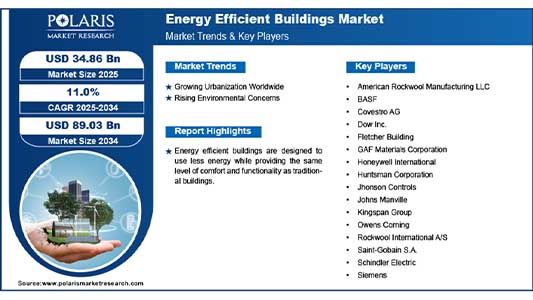The global energy efficient buildings market size is expected to reach USD 89.03 billion by 2034, according to a new study by Polaris Market Research. The report “Energy Efficient Buildings Market Size, Share, Trends, Industry Analysis Report: By Material [Glass Wool, Mineral Wool, Expanded Polystyrene (EPS), and Extruded Polystyrene (XPS)], Component Type, Application, and Region (North America, Europe, Asia Pacific, Latin America, and Middle East & Africa) – Market Forecast, 2025–2034” gives a detailed insight into current market dynamics and provides analysis on future market growth.
Energy-efficient buildings are designed to minimize energy usage while maintaining comfortable living and working conditions. This is achieved through advanced construction techniques, innovative technologies, and sustainable materials that enhance the efficiency of heating, cooling, lighting, and overall energy management systems.
The energy efficient buildings market growth is driven by rising energy costs, stringent government regulations, and growing awareness of environmental sustainability. Many countries have implemented building codes and standards, such as the Leadership in Energy and Environmental Design (LEED) certification and the Building Research Establishment Environmental Assessment Method (BREEAM), to encourage energy-efficient building practices. Governments are also offering incentives, such as tax credits and subsidies, to promote energy-efficient and green buildings.
Do you have questions? Request a sample or make an inquiry before buying this report by clicking the link below: https://www.polarismarketresearch.com/industry-analysis/energy-efficient-buildings-market/request-for-sample
Technological advancements play a crucial role in propelling the energy efficient buildings market development. Smart building technologies, including Internet of Things (IoT) devices, sensors, and advanced energy management systems, enable real-time monitoring and optimization of energy consumption. For instance, smart thermostats and lighting systems adjust usage based on occupancy and environmental conditions, reducing waste and lowering operational costs. Additionally, the integration of renewable energy sources, such as solar panels and wind turbines, into building designs enhances energy efficiency and reduces dependency on conventional energy grids.
Energy Efficient Buildings Market Report Highlights
- In terms of material, the expanded polystyrene (EPS) segment is estimated to grow at a robust pace in the coming years owing to its excellent insulation performance, durability, and adaptability to various applications.
- Based on application, the residential segment dominated the energy efficient buildings market share in 2024 due to increasing awareness of energy conservation among homeowners and rising demand for sustainable living spaces.
- In the global market, the Europe energy efficient buildings market held the highest revenue share in 2024 due to stringent energy efficiency regulations and the widespread adoption of sustainable construction practices.
- The North America energy efficient buildings market is expected to grow at a rapid pace during the forecast period owing to the increasing investments in green infrastructure and rising demand for sustainable building solutions.
- A few of the key market players are Kingspan Group, Covestro AG, Dow Inc., Huntsman Corporation, Rockwool International A/S, Fletcher Building, American Rockwool Manufacturing LLC, Saint-Gobain S.A., Owens Corning, Johns Manville, GAF Materials Corporation, BASF, Jhonson Controls, Siemens, Honeywell International, and Schindler Electric.
Polaris Market Research has segmented the energy efficient buildings market report on the basis of material, component type, application, and region:
By Material Outlook (Revenue, USD Billion, 2020–2034)
- Glass Wool
- Mineral Wool
- Expanded Polystyrene (EPS)
- Extruded Polystyrene (XPS)
By Component Type Outlook (Revenue, USD Billion, 2020–2034)
- Ventilation Systems
- Lighting Technologies
- Energy Management Systems
- Controls
By Application Outlook (Revenue, USD Billion, 2020–2034)
- Residential
- Commercial
By Regional Outlook (Revenue, USD Billion, 2020–2034)
- North America
- US
- Canada
- Europe
- Germany
- France
- UK
- Italy
- Spain
- Netherlands
- Russia
- Rest of Europe
- Asia Pacific
- China
- Japan
- India
- Malaysia
- South Korea
- Indonesia
- Australia
- Vietnam
- Rest of Asia Pacific
- Middle East & Africa
- Saudi Arabia
- UAE
- Israel
- South Africa
- Rest of Middle East & Africa
- Latin America
- Mexico
- Brazil
- Argentina
- Rest of Latin America
Energy Efficient Buildings Market Report Scope
| Report Attributes | Details |
| Market Size Value in 2024 | USD 31.47 billion |
| Market Size Value in 2025 | USD 34.86 billion |
| Revenue Forecast by 2034 | USD 89.03 billion |
| CAGR | 11.0% from 2025 to 2034 |
| Base Year | 2024 |
| Historical Data | 2020–2023 |
| Forecast Period | 2025–2034 |
| Quantitative Units | Revenue in USD Billion and CAGR from 2025 to 2034 |
| Report Coverage | Revenue Forecast, Market Competitive Landscape, Growth Factors, and Trends |
| Segments Covered | By MaterialBy Component TypeBy Application |
| Regional Scope | North AmericaEuropeAsia PacificLatin AmericaMiddle East & Africa |
| Competitive Landscape | Energy Efficient Buildings Industry Trend Analysis (2024)Company Profiles/Industry participants profiling includes company overview, financial information, product/service benchmarking, and recent developments |
| Report Format | PDF + Excel |
| Customization | Report customization as per your requirements with respect to countries, regions, and segmentation. |
| For Specific Research Requirements | Request for Customized Report |
License and Pricing
Single User – $ 4250Multi Users (Up to 20 User) – $ 5250Enterprise License – $ 6250
Purchase Report Sections
- Regional analysis
- Segmentation analysis
- Industry outlook
- Competitive landscape













